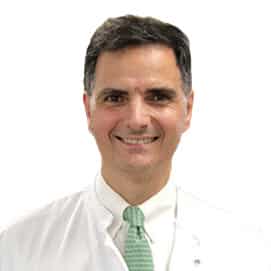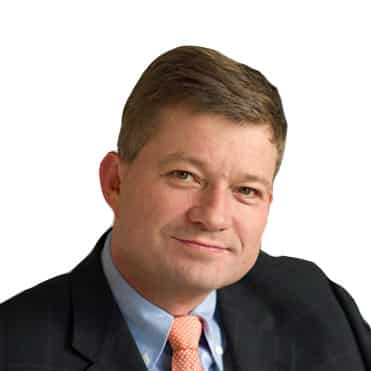As part of numerous clinical trials that are taking place throughout Germany, physicians and scientists are constantly striving to improve the diagnosis and treatment of malignant lymphomas. Leading experts in the field of lymphoma treatment have come together to coordinate the knowledge they have gained through research to enable patients to receive optimal treatment according to the latest standard.
Radiation therapy
Radiation therapy is usually given in combination with chemotherapy (radiochemotherapy) or after chemotherapy. Radiation therapy for adults may be sufficient only in selected cases and only in the early stages of the disease. During radiation therapy in adult patients, the affected lymph nodes and adjacent areas with lymphatic vessels draining lymph are irradiated. Children receive what is called modified radiation therapy of involved fields to reduce the size of the irradiated region. In this case, the affected lymph nodes are irradiated in compliance with the appropriate safe distance. The goal of therapy is to destroy the tumor in the radiation field without serious damage to adjacent healthy tissue.
Irradiation is carried out over a period of approximately four to six weeks. Treatment can be carried out on an outpatient basis. The standard radiation dose according to the German Hodgkin's Lymphoma Study Group (GHSG) is 20 Gray in the early stages or 30 Gray in the middle or advanced stages. Irradiation of Hodgkin lymphomas with lymphocytic predominance in stage IA without any risk factors is carried out with a dose of 30 Gy. With daily irradiation with single doses of 1.8 - 2.0 Gy five times a week, the duration of radiation therapy will be about 2-4 weeks.
Chemotherapy
Chemotherapy for Hodgkin's lymphoma consists of the use of various drugs that have either a cell-damaging (cytotoxic) or inhibitory effect on their growth and are called cytostatics. As a rule, various cytostatics are combined with each other (the so-called polychemotherapy). According to recognized international treatment protocols, cytostatic drugs are administered in a certain dosage and at certain time intervals.
In Germany today, primarily the so-called ABVD and BEACOPP schemes. Each letter in the names of the schemes denotes a specific cytostatic drug. The schemes are repeated for so long until the set number of courses is reached. After the end of chemotherapy, if necessary, radiation therapy is performed.
Which therapy regimen will be used and how many courses are required depends on the stage of the disease. In later stages (stage IIB with risk factors for non-nodular involvement and/or large mediastinal tumor, and stages III and IV), eight cycles of chemotherapy are typically administered. The duration of such treatment is six to seven months. The German Hodgkin's Lymphoma Study Group (GHSG) standard for the treatment of patients with advanced Hodgkin's lymphoma below the age of 60 years outside the study is currently 8 cycles of high-dose BEACOPP therapy (high-dose version of the BEACOPP regimen) plus additional radiotherapy with a dose of 30 Gy (for explanations, see the paragraph "Radiation therapy") on residual tissues ≥ 1.5 cm.
Operation
For patients over 60 years of age with advanced disease, the current standard outside of the study is 6-8 cycles of ABVD chemotherapy, depending on response to treatment and side effects. If the size of the residual tissue is ≥1.5 cm, additional radiation therapy with a dose of 30 Gy is required (for explanations, see the paragraph "Radiotherapy").
For early disease management (stages I and II without risk factors), a new standard was set in 2010 through the final evaluation of the HD10 trial by GHSG. This new standard calls for treatment with 2 cycles of ABVD chemotherapy followed by radiotherapy to the involved fields at a reduced dose of 20 Gy (see radiotherapy for explanation).
For treatment in the middle (intermediate) stages (stage I and IIA with one or more risk factors, and stage IIB with only a risk factor for elevated ESR and/or with three or more lymph node regions affected), new recommendations based on evaluation of the HD4 GHSG study. Outside of studies, 2 courses of therapy according to the BEACOPP eskaliert scheme should be carried out, followed by 2 courses of therapy according to the ABVD scheme. At the end, irradiation is performed (involved fields, with a dose of 30 Gray, see the explanation in the paragraph “Radiotherapy”).
Treatment for relapses
If during therapy or within the first three months after the end of therapy, a further spread of the disease is detected, then we are talking about its progression. In this case, it is necessary to use high-dose chemotherapy followed by transplantation of autologous (own) stem cells.
We are talking about the so-called early relapse if more than three months have passed since the end of therapy, but less than one year, and Hodgkin's lymphoma was again confirmed in the histological examination. In most cases, high-dose chemotherapy with a final transplant of autologous stem cells is also used here.
If there is a so-called late relapse, then the therapy was completed more than a year ago, and there are various treatment options. The decisive point in the treatment in this case is how far the lymphoma has spread to date, what types of treatment the patient has already received, what type of lymphoma was found on histology, and also how old the patient is. In certain cases, radiation alone may be sufficient, in others, powerful high-dose chemotherapy such as BEACOPP is required. In all other cases, high-dose therapy is also required, followed by transplantation of autologous stem cells.
To reduce the tumor mass today, before high-dose therapy, 2 courses of chemotherapy according to the DHAP scheme are recommended. Between cycles, your own stem cells are collected. This is followed by the so-called high-dose therapy (eg BEAM) and finally the stem cell transfer. High-dose therapy damages the bone marrow so severely that without the transfer of autologous stem cells, the production of white blood cells, red blood cells, and platelets can stop for a very long period of time.
If Hodgkin's lymphoma does not respond to treatment or comes back many times, depending on age and health, consideration should be given to the introduction of foreign stem cells (allogeneic stem cell transplant). But with Hodgkin's lymphoma, this is an experimental method. If allogeneic stem cell transplantation is being considered, moderate chemotherapy can be used to prevent further progression of the disease or push it into the background to preserve the patient's quality of life. But with moderate chemotherapy, recovery is impossible.
Treatment of children and adolescents under the age of 18
Unlike adult patients, children and adolescents with Hodgkin's lymphoma are treated according to the same research protocol in Germany and in other parts of Europe. The chances of curing the disease in children and adolescents are generally very high. Long-term effects of treatment, such as infertility or an increased risk of developing other types of cancer, should be avoided where possible. For this reason, in the early stages of tumor development, the indications for radiation are as limited as possible. For example, children with early-stage cancer first receive two courses of chemotherapy. Patients with middle and advanced stages of the disease receive four to six courses of chemotherapy. And only with an insufficient response to treatment, radiation therapy is performed.
The effectiveness of the treatment of patients with all stages of the development of lymphoma is checked using CT/MRI and PET with FDG. Patients who show a metabolically complete response on FDG-PET and at least a partial response on CT/MRI after two cycles of chemotherapy are no longer receiving radiation in current therapy trials. At the same time, the OEPA protocol is used for chemotherapy, and in the middle and late stages - CODAC as a combination of chemotherapy.
The use of procarbazine is completely abandoned. Procarbazine is a drug that can cause infertility in men. Patients with Hodgkin's lymphoma with lymphocytic predominance in stages IA and IIA have been treated since 11/01/2009 according to a new protocol distributed throughout Europe, which provides for minimal therapy for such patients in order to avoid side effects as far as possible. Stage IA patients with complete lymph node resection do not receive any other treatment under this protocol. More than 70% patients who underwent surgery alone are expected to recover.
Head of the Clinic of Oncology, Hematology and Palliative Medicine
Video
Request appointment
Useful links
Photo gallery








